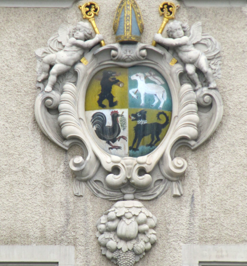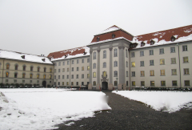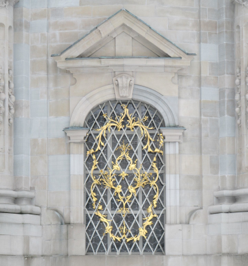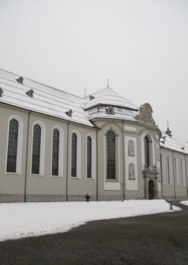abbey of St. Gallen
st. gallen, switzerland
Europe
January 27, 2011


abbey of St. Gallen
st. gallen, switzerland
Europe
January 27, 2011




The Abbey of St. Gallen (also referred to as the Abbey of St. Gall) has an impressive number of buildings including a monastery, its cathedral, a library, and a palace residence of the former prince-abbots. It became a UNESCO World Heritage Site in 1983. The Abbey of St. Gallen was one of the chief Benedictine abbeys in Europe. In 719-720 during the reign of Pepin the Short, Saint Othmar founded the Carolingian style Abbey of St. Gallen on the site where Saint Gall had built his hermitage. Under Abbot Waldo of Reichnau (740-814) numerous Anglo-Saxon and Irish monks undertook the laborious task of copying the manuscripts, and a famous library was gathered where letters and sciences flourished. At the request of Charlemagne, Pope Adrian sent chanters to the abbey from Rome, propagating the use of Gregorian chants. In the following century, the Abbey of St. Gall had conflicts with the Bishopric of Konstanz that had acquired jurisdiction over the Abbey of Reichenau on the Bodensee. During the 9th century, King Louis the Pious (ruled 814-840) confirmed the independence of the Abbey, ending the conflict with Konstanz. In 954 the monastery and buildings were surrounded by a wall to protect the abbey and a town grew up around these walls. In the 13th century, the Abbey and the town became an independent principality, over which the abbots ruled as territorial sovereigns ranking as Princes of the Holy Roman Empire. In the late 14th century, the farmers of the Abbot’s personal estates began seeking independence. The Appenzell Wars followed, and the town of St. Gallen became member of the Swiss Confederation in 1454. Three years later, in 1457, St. Gallen became an independent town, free of the Abbot’s rule. In 1524, the town of St. Gallen adopted the Reformation, though the Abbey remained Catholic, damaging the relationship between the two powers, though both were admitted to the Swiss Tagsatzung or legislative assembly as close associates of the Swiss Confederation. Problematic to the Abbey, Calvinist groups raided the Abbey during the 16th century, showing no respect for the old books. A restoration of the Abbey was begun by Abbot Diethelm in 1530, adding schools and a library building. Under Abbot Pius (1630-74) a printing press was started at the Abbey. In 1712, during the Toggenburg War, the Abbey of St. Gallen was pillaged by the Swiss who took most of the books and manuscripts to Zürich and Bern. The Abbey turned to the townspeople for protection, strengthening the role of the citizens of St. Gallen. The Abbey and its surrounding town remained the largest city-state in Switzerland with a population of more than 77,000 citizens. During the 18th century, most of the Medieval monastery was demolished and new structures were built, including a Late Baroque/Rococo style cathedral and a library. In 1798, Napoleon invaded the Old Swiss Confederation, destroying the Ancien Régiime. Under the Helvetic Republic, both the abbey and the city lost their power and were combined along with Appenzell into the Canton of Sántis. The Helvetic Republic was widely unpopular in Switzerland and was overthrown a few years later, in 1803. Following the Act of Mediation, St. Gallen became the capital of the Protestant Canton of St. Gallen. One of the first acts of the new canton was to suppress the power of the abbey. The Prince-Abbot’s secular power was suppressed and the Abbey was secularized. The monks were driven out of the Abbey of St. Gallen, moving to other abbeys. The last abbot died in Muri in 1829. In 1846, a rearrangement in the local dioceses made St. Gall a separate see, with the abbey church as cathedral and a portion of the monastic buildings reassigned for the bishop’s residence.
PHOTOS: Left Column: 1.View of the Prine-Abbot’s palace at the Abbey of St. Gallen. 2 & 3. Monastery buildings surrounding the cathedral at the Abbey of St. Gallen. 4. View of the Prine-Abbot’s palace at the Abbey of St. Gallen. 5. View of the entrance to the Cathedral of St. Gallen, the doorway in the center of the long side of the rectangular structure. Center, Top: The heraldic shield of the Bishop of the Abbey of St. Gallen. The bear in the upper left corner of the shield refers to the bear, who was instructed by St. Gall to build the hermitage, c. 621. The monk rewarded him with bread on the condition that he leave and never return. Center, Middle: Detail: the gilded ironwork in Late Baroque style on a window grating of the chancery in the Cathedral of St. Gallen. Center, Bottom: Entrance to the Abbey’s monastery building, with a stairway leading to the Library of St. Galen. Right Column: 1. The Cathedral of St. Gallen. 2.Portal of the Cathedral of St. Gallen. 3. Architectural detail around the portal of the Cathedral of St. Gallen.


Benedictine Abbey







